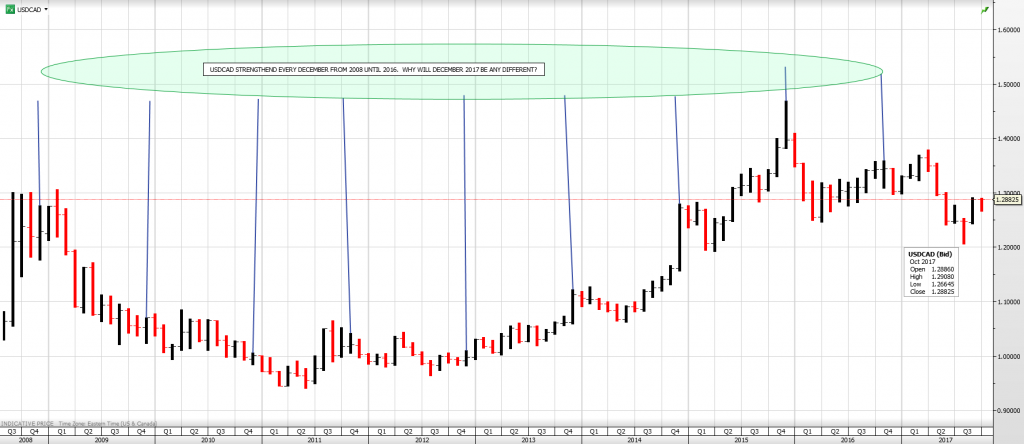By Michael O’Neill
Oil prices soared in November, rising 9.5%.The Canadian dollar did not. It didn’t lose anything, either. Instead, it opened in New York on the last day of the month at the same level it closed, on October 31. What “monkey business” is this?
Domestic and American developments overshadowed oil price movements and for a good reason. USDCAD trader’s expected oil price volatility ahead of the November 30 Opec meeting so downplayed price gains. The Bank of Canada policy statement on October 25 was dovish and cautious, leading to many economists downgrading their expectations for future rate hikes.
The NAFTA negotiations were another cause for concern for USDCAD traders. Round 5 ended on November 21, and there wasn’t any progress on major issues. Canada Foreign Minister Chrystia Freeland said that some of the US proposals were extreme and something “we simply can’t agree to.”
US tax reform discussions were another source of USDCAD demand. President Trump and the Republicans are motivated to get a deal concluded before year end. Progress has been slow, but there is progress. This week, the Senate Budget Committee approved the tax bill setting the stage for a full Senate vote in the very near future. That development has underpinned the greenback even though there are many hurdles to leap before the bill gets to President Trump’s desk.
The US dollar got added support from changes at the Federal Reserve. President Trump did not nominate Fed Chair Janet Yellen for a second term. His choice, current Federal Reserve board member Jerome Powell, is seen as a slightly less dovish but non-disruptive replacement.
The 173rd (Ordinary) Opec meeting in Vienna is winding down, and as it does, oil prices are slipping from their lofty levels. The move may merely be a case of traders “buying the rumour and selling the fact” and booking some profits.
Opec paints a somewhat rosy outlook for the future.
The President of the Opec Conference and Saudi Arabia Oil Minister Khalid Al-Falih’s opening remarks bragged that the goals announced in the “Declaration of Cooperation” were on track to be achieved.
He noted that the OECD stock overhang of 280 million barrels above the five year-moving average dropped nearly 50% to 140 million barrels. He indicated that floating storage volumes had decreased by 50 million barrels as well. He said market stability has improved and the sentiment was upbeat.
Russia and Opec agreed to extend production cuts until the end of 2018. Progress would be reviewed in June.
The prospect of steady to higher oil prices may not lead to short-term Canadian dollar gains but instead just act as a drag on losses.
The Canadian dollar has not fared very well in December. USDCAD has rallied every December since 2008. Why not December 2017 as well?
Chart: USDCAD monthly noting every December since 2008
The European Union and the United Kingdom are playing their own “Barrel of Monkeys” game, and this barrel is filled with money. The EU, perhaps miffed at the audacity of the UK to opt out of the 44-year-old union, is ransoming an EU trade relationship, for cold hard cash.
In July, UK Foreign Minister Boris Johnston said in the House of Commons, in reference to another MP’s comments, that the EU could “go whistle.”
Well, the EU did indeed whistle, and Prime Minister Theresa May heard it loud and clear. The UK is now saying they are willing to pay £50 billion to jump-start the trade negotiation phase of the Brexit discussions.
The UK and EU still need to whistle up an agreement on the Republic of Ireland and Northern Ireland border issue. Currently, there isn’t a border or even a checkpoint. The Republic of Ireland is demanding a rock-solid guarantee that there will not be a border between the two Irelands. Northern Ireland’s Democratic Unionist Party (DUP) is threatening to end its support for Prime Minister May’s government if Northern Ireland is treated differently from the rest of the UK.
Sterling rallied dramatically in the past two weeks. The thought of a “soft” Brexit and the risk of higher UK interest rates boosted GBPUSD and GBPCAD by default. GBPCAD climbed 5% and traded at 1.7445 on November 30. That demand is another reason why USDCAD prices have been underpinned.
Better than expected Eurozone data and comments from ECB officials alluding to a September 2018 end for quantitative easing have lifted EURUSD above major resistance levels and opened the door to further gains. EURCAD also rose.
The Canadian dollar is heading into year-end on the defensive even though oil prices are at 30-month highs. Canada/US interest rate differentials are widening in America’s favour, and cross-currency buying against the Loonie is lifting USDCAD. So are fears that the Fed may turn hawkish and Nafta collapses. High oil prices are a benefit but at current levels, not high enough to offset the risks.







